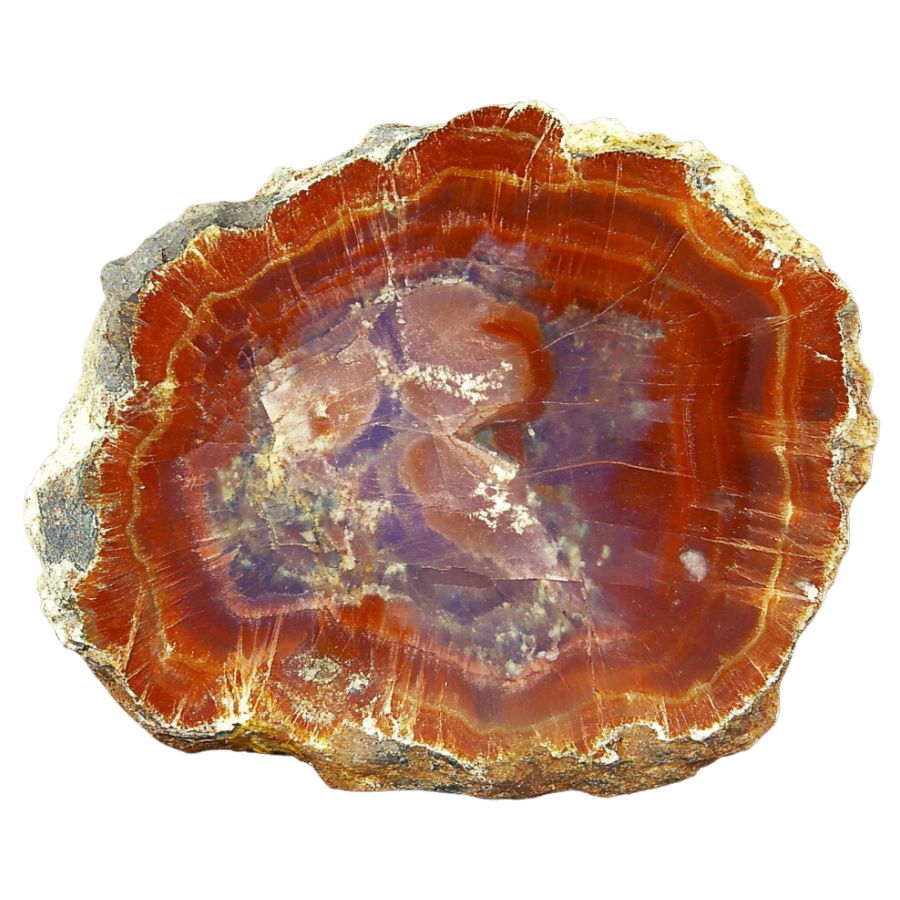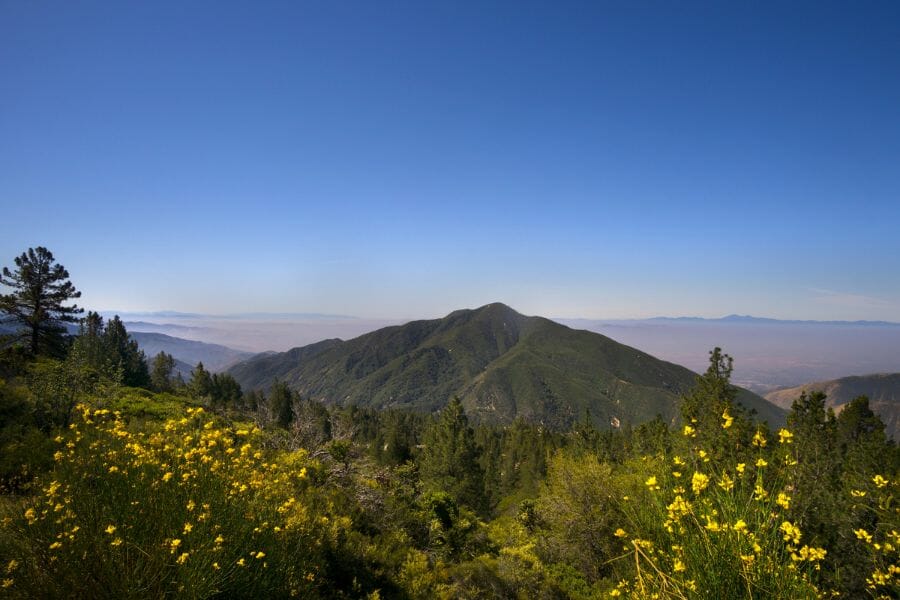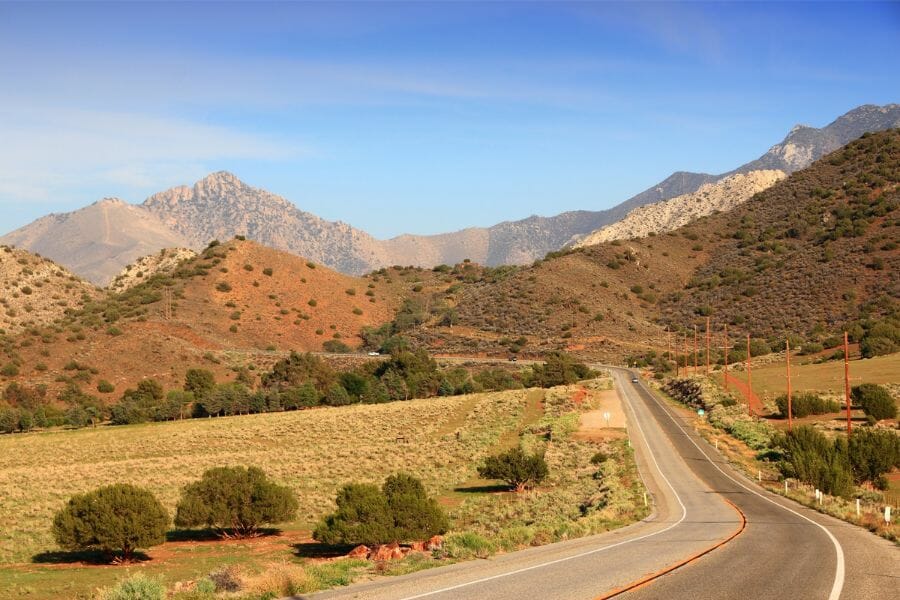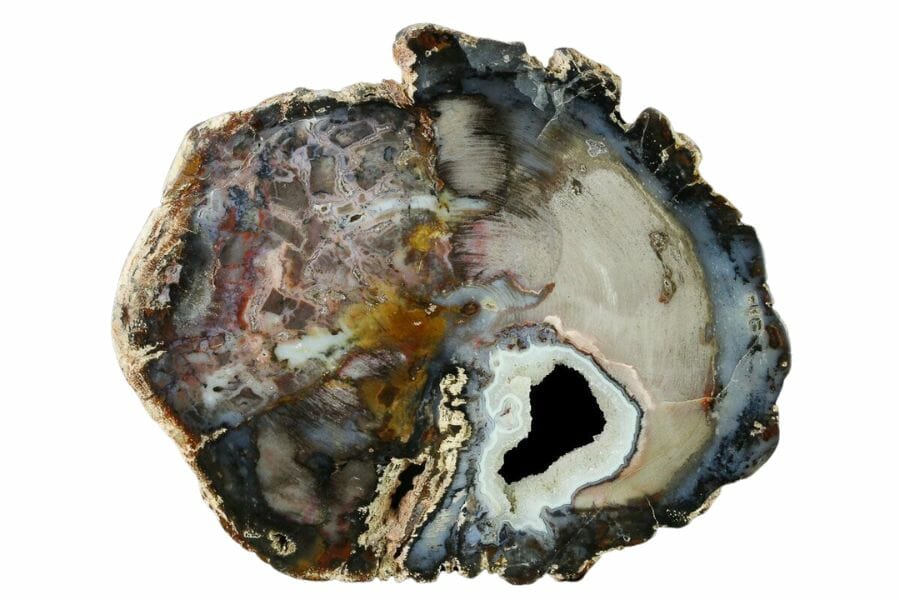Exploring the state’s rugged terrain offers a unique opportunity to discover petrified wood, a fossilized treasure from ancient forests. With the right tips, you’ll be ready to embark on your own adventure and uncover these fascinating remnants of prehistoric life.
Knowing where to look and what to expect will increase your chances of spotting these remarkable pieces scattered across this great state’s terrain!
Petrified wood you can find in the US
In the United States, several types of petrified wood can be found, each with unique characteristics based on the original tree species and the minerals involved in the fossilization process. Here are some of the types you’ll be able to find.
Araucarioxylon

Found in the Petrified Forest National Park in Arizona, this is one of the most famous types of petrified wood. It comes from an extinct species of conifer. As Arizona’s state fossil, Araucarioxylon holds a special place in the state’s natural history.
These trees once formed vast forests during the Late Triassic period, about 225 million years ago. The vibrant colors in this petrified wood come from minerals that replaced the original tree material over time.
Metasequoia

Often referred to as dawn redwood, this type of petrified wood can be found in various parts of the U.S., including the Pacific Northwest. Metasequoia was once thought to be extinct until living trees were later discovered in China.
Furthermore, its fine grain and reddish-brown color are characteristic features.
Palmoxylon

This petrified wood originates from palm trees and is often found in the Gulf Coast states like Texas and Louisiana. Recognized as the state stone of Texas, Palmoxylon is abundant and holds cultural significance.
The wood’s unique speckled or dotted pattern comes from the vascular bundles of the original palm tree. These fossils date back to the Cretaceous period, when the area was tropical and teeming with life.
Taxodium

Also known as bald cypress, this petrified wood can be found in the southeastern U.S., particularly in areas that were once swampy. Taxodium wood is often found in places that were ancient swamps, where these trees thrived millions of years ago.
The wood is durable and shows intricate grain patterns, with growth rings and knotholes that tell the story of its long history. It’s a fascinating glimpse into the wet environments that once dominated the Southeast.
Sequoioxylon

Petrified wood from ancient sequoia trees, found in places like California, where sequoia forests once thrived. These trees are the ancestors of the giant sequoias that still stand in California today.
The petrified wood is notable for its large, straight grain and reddish color, reflecting the immense size and age of the original trees.
Ginkgoxylon

Petrified wood from ancient ginkgo trees, which can sometimes be found in states like Oregon and Washington. Ginkgo is one of the oldest tree species on Earth, with fossils dating back over 200 million years.
Ginkgo petrified wood often has a light color and may show patterns similar to the fan-shaped leaves of the living ginkgo.
Dicotyledonous Wood

Found across various states, this type of petrified wood comes from broadleaf trees, making it more common and varied in appearance. You can spot dicotyledonous wood by the distinct vessels and growth rings that indicate seasonal changes.
This type of petrified wood is often found in regions that were once temperate forests, offering clues about the diverse plant life that existed millions of years ago.
Piceoxylon

Petrified wood from ancient spruce trees, commonly found in areas like Wyoming and Montana, where coniferous forests once thrived. Piceoxylon is known for its straight grain and pale color, often showing growth rings that tell the tree’s life story.
These trees were part of the ancient boreal forests that covered large parts of North America during cooler periods.
A Quick Request About Collecting
Always Confirm Access and Collection Rules!
Before heading out to any of the locations on our list you need to confirm access requirements and collection rules for both public and private locations directly with the location. We haven’t personally verified every location and the access requirements and collection rules often change without notice.
Many of the locations we mention will not allow collecting but are still great places for those who love to find beautiful rocks and minerals in the wild without keeping them. We also can’t guarantee you will find anything in these locations since they are constantly changing.
Always get updated information directly from the source ahead of time to ensure responsible rockhounding. If you want even more current options it’s always a good idea to contact local rock and mineral clubs and groups
What Rough Petrified Wood Looks Like
Most of the photos you find of petrified wood are pieces that have been cut and polished. That is certainly useful but isn’t super helpful once you are out in the field. This is what you should look out for once you start hunting:
Exteriors like this

Every type of petrified wood has a different exterior and pattern but this is a good starting point on what to look for.
Texture and grain patterns

One of the most distinctive features to look for is the texture and grain patterns. Petrified wood often retains the original structure of the tree, including the grain, knots, and even growth rings. These patterns can appear similar to modern wood but are typically more rigid and fossilized.
Examine the surface for any linear patterns or striations that indicate the original wood grain. The texture may feel smoother or more polished in certain areas where mineralization has created a glassy effect.
Coloration and mineralization

The color of petrified wood can vary significantly due to the minerals that replaced the organic material during the fossilization process. Common colors include shades of brown, red, yellow, orange, and black.
Some pieces might even exhibit multiple colors in intricate patterns. These colors are often more vivid and diverse than those found in regular rocks. When inspecting potential petrified wood, look for these distinct and varied hues, which can indicate the presence of different minerals such as silica, iron, manganese, and others that contributed to the petrification process.
Bark and exterior features

Another telltale sign of petrified wood is the presence of bark impressions or external textures that resemble tree bark. These features are often well-preserved and can include the rough, fibrous texture of bark, knots, or other surface irregularities typical of natural wood.
The exterior of rough petrified wood may also have a weathered appearance, with cracks and fractures that occurred as the wood fossilized over millions of years. Look closely for these natural wood features, as they can be a strong indicator that you have found a piece of petrified wood.
Weight and density

Petrified wood is typically much heavier and denser than regular wood due to the mineralization process. When rockhounding, pick up the specimen to feel its weight. Even small pieces of petrified wood will feel significantly heavier than an equivalent-sized piece of non-fossilized wood.
This increased density is due to the replacement of organic material with minerals, making petrified wood feel more like a rock than wood. Comparing the weight and density of your find with known samples of petrified wood can help confirm its authenticity.
- The extensive local experience of our team
- Input from a variety of local rockhounds and rockhound groups
- The difficulty in accessing a location
- Safety and potential hazards when collecting
- Private and public locations
- A desire to include locations for both the experienced and newbie hunters who are just starting out
Using these inputs we think we’ve put together the best list out there for those who love finding petrified wood for our collections!
General Areas To Try First

Before we get into the specific places you should be looking we wanted to give you some more general advice. Once you get to your hunting area you should head straight for these areas if you want to have the best results:
Lakeshores

Lakeshores are like natural garbage cans because all things wash up and get left there over time. That includes wood that has turned to stone. As the water rises and falls, it carries sediment and rocks. It also takes the fossilized remains of trees from long ago.
Most lakeshores have a variety of rocks and minerals, which makes them an excellent place for petrified wood to grow and thrive. You’ll find a nice mix of sedimentary and volcanic rocks, the best sites for preserving wood fossils.
Roadcuts

When building roads, parts of the ground are often cut away to make a smooth path. The magic happens when the road cuts through layers of rock and soil. Petrified wood is often buried deep underground, and roadcuts let us see these underground wonders.
As workers blast through the rock layers, they accidentally find petrified wood that has been there for hundreds of years. Petrified wood is easy for collectors to spot because the exposed rock layers of roadcuts make it easy to see its unique patterns and colors.
Streams and creeks

Streams and creeks can move loose sediment away, which can reveal old wood that has turned to stone. As the water moves around, it exposes small pieces or even more significant amounts of petrified wood that have settled on the streambed.
Streams and creeks are more accessible for collectors because they are not as big. You can easily walk along their banks, jump from rock to rock, and look for petrified wood at the water’s edge.
River beds

Riverbeds are excellent for finding petrified wood due to their unique geological and environmental conditions. Rapid burial by sediments like sand, silt, and mud protects fallen trees from decay, initiating the fossilization process.
Mineral-rich waters flowing through rivers facilitate the replacement of organic material with minerals such as silica, turning wood into stone. Over time, erosion exposes these buried treasures, making them accessible for discovery.
This dynamic environment, with constant sediment deposition and mineral infiltration, creates ideal conditions for the formation and eventual exposure of petrified wood.
DON'T MISS OUT ON ANY GREAT FINDS!
While you're out searching for Petrified Wood you're going to find A LOT of other interesting rocks and minerals along the way. The last thing you want to do is toss out something really interesting or valuable. It can be easy to misidentify things without a little guidance.
We've put together a fantastic field guide that makes identifying 140 of the most interesting and valuable rocks and minerals you will find REALLY EASY. It's simple to use, really durable, and will allow you to identify just about any rock and mineral you come across. Make sure you bring it along on your hunt!
The Best Places To Find Petrified Wood In California
If you’ve checked out the best rockhounding spots in California, it’s time to zero in on the best places for petrified wood. Below are spots that are proven to have some pretty amazing petrified wood specimens.
Always Confirm Access and Collection Rules!
Before heading out to any of the locations on our list you need to confirm access requirements and collection rules for both public and private locations directly with the location. We haven’t personally verified every location and the access requirements and collection rules often change without notice.
Many of the locations we mention will not allow collecting but are still great places for those who love to find beautiful rocks and minerals in the wild without keeping them. We also can’t guarantee you will find anything in these locations since they are constantly changing.
Always get updated information directly from the source ahead of time to ensure responsible rockhounding. If you want even more current options it’s always a good idea to contact local rock and mineral clubs and groups
Petrified Forest

Nestled in the heart of wine country, near Calistoga, the Petrified Forest is a window into ancient times. Picture this: a lush forest from millions of years ago, now turned into beautiful stone.
The terrain is a mix of rolling hills and pathways, perfect for a leisurely stroll. As you walk, you’ll spot massive logs, now stone-solid, scattered about.
They’re remnants of an ancient volcanic eruption that buried the forest, kick-starting the petrification process.
Geologically speaking, it’s a rockhound’s dream. The minerals that seeped into the wood over ages have painted a vivid palette of reds, blues, and yellows onto these ancient logs.
Getting there is a breeze. It’s just a short drive from the town of Calistoga, with clear signs pointing the way. So, if you’re in the mood for an adventure that mixes geology with a bit of ancient history, the Petrified Forest is the spot to be.
Before you go, make sure that you’re familiar with California’s rockhounding guidelines.
Where we found petrified wood in the Petrified Forest
There’s California petrified wood all around in this area, many of which were once redwoods. You’ll see them pretty easily as you explore the forest.
However, make sure that you don’t take any pieces of petrified wood or other rocks with you. If you want a piece of petrified wood from the forest, the best thing to do would be to buy one from the park’s gift shop.
San Bernardino County

San Bernardino County in California is like a treasure chest for rock enthusiasts like us! Covering a vast expanse, it’s the largest county in the U.S.
Geographically, it boasts a mix of rugged mountain ridges, sweeping desert sands, and hidden canyons.
Geologically, San Bernardino is a goldmine. From ancient marine fossils to sparkling minerals and, yes, even petrified wood, there’s a little something for every rockhound.
Specifically, for petrified wood, places like the Mojave National Preserve are a must-visit.
The preserve holds secrets from eons ago, and with a keen eye, you might just stumble upon some ancient wood turned to stone.
Getting to San Bernardino County is easy peasy. Major highways crisscross the region, and it’s just a drive away from major cities like Los Angeles.
Where we found petrified wood in San Bernardino County
You can find petrified wood in and around the Mojave National Preserve, such as Kessler Peak and the Goffs and Nipton areas. If you’re in the Afton area, you’ll probably be able to find pieces along the Mojave River.
Follow the Mojave Freeway and go further west, and you’ll also probably have some success in Manix, Mule Canyon, and Kramer.
Warner Mountains

The Warner Mountains are located in the northeastern part of the state, these mountains rise majestically, like nature’s skyscrapers. They stretch out, forming a rugged backbone against the skyline.
Terrain-wise, it’s a hiker’s paradise. Trails weave through dense forests, past shimmering lakes, and up to vistas that’ll take your breath away. Every twist and turn feels like stepping into a new world.
From a geology standpoint, the Warners are fascinating. They’ve got a rich volcanic history, which means tons of interesting rocks and formations.
For collectors, there’s a rainbow of minerals to discover. Plus, the erosion has revealed layers of Earth’s history, just waiting to be explored.
For those itching to visit, heading to the Warner Mountains is a cinch. Though they’re tucked away, the main roads leading there are well-marked.
Whether you’re coming from the coast or the city, just set your GPS, pack some snacks, and enjoy the scenic drive.
Where we found petrified wood at the Warner Mountains
If you search on the east side of the Warner Mountains, there’s a good chance that you’ll come across some petrified wood and even other gemstones. Look in the canyons, among the exposed rock.
Before you go, however, make sure that you check if there are any rockhounding guidelines that you’ll have to follow.
Red Rock Canyon State Park

Tucked in the southernmost tip of the Sierra Nevada range, the Red Rock Canyon State Park is a splash of vibrant colors on Earth’s canvas.
Imagine cliffs and buttes painted in shades of red, orange, and pink – it’s like Mother Nature went wild with her paintbrush here!
The terrain is a rock lover’s playground. You’ve got dramatic rock formations, deep valleys, and even those iconic eroded bluffs that look like they’re straight out of a wild west movie. Every nook and cranny tells a story.
Speaking of stories, the geology of Red Rock Canyon is a tale of ancient lakes, winds, and time. These rocks have seen it all, from prehistoric creatures to shifting landscapes. There are layers upon layers of history here, just waiting to be read.
Getting to the park is a piece of cake! It’s off Highway 14, a hop and a skip from Los Angeles. The drive itself offers some stunning vistas. So, if you’ve got a heart for adventure and eyes for beauty, Red Rock Canyon State Park is the place to be.
Where we found petrified wood at the Red Rock Canyon State Park
The Red Rock Canyon State Park is a pretty great place to explore. People have been successful in finding California petrified wood in Last Chance Canyon, which is right at the boundary of the park, along Last Chance Canyon Road.
You might also find more petrified wood, as well as other rocks and minerals, further up Last Chace Canyon Road and around the defunct Cudahy Camp.
However, it’s important to note that taking rocks and other objects from the park is prohibited.
Kern County

Kern County is filled with natural wonders and fascinating geology. Located in the southern part of the Central Valley, it’s known for its vast desert landscapes and beautiful mountains.
You’ll find the Sierra Nevada to the east and the Tehachapi Mountains to the south.
The geography in Kern County is a mix of valleys, mountains, and plateaus. There are wide-open spaces that contrast with the towering peaks.
The terrain varies, from flat farmland to rugged mountain trails, so there’s something for every adventurer.
Geologically, it’s a goldmine of mineral deposits like gold, tungsten, and oil. The area is rich with fossils, and if you’re lucky, you might even stumble upon some petrified wood!
Major highways crisscross the area, making Kern County easily accessible by car. If you’re flying, Meadows Field Airport in Bakersfield is right there, and once you land, the county’s many natural wonders are just a short drive away.
Where we found petrified wood in Kern County
There are plenty of areas in Kern County that you can explore to find petrified wood. You can check out the Cantil area just south of the Red Rock Canyon State Park, as well as the area around the McKittrick Brea Pit.
Other spots known for petrified wood in the county include Gem Hill in Rosamond, Boron, and Willow Springs. The town of Mojave is also worth exploring.
Other Great Places To Find California Petrified Wood

If you’ve ever wondered how to find petrified wood, it’s all about knowing where to look and what to look for.
Whether you’re an experienced collector or just beginning your rockhounding journey, the Golden State’s landscape is ready to reveal its secrets. Below is a list of different spots, arranged by county to make them easier to navigate.
| County | Location |
| Amador County | Volcano Mining District |
| Calaveras County | Campo Seco area |
| Calaveras County | Valley Springs area |
| Del Norte County | Crescent City area beaches |
| Fresno County | Coalinga creek bed |
| Glenn County | Black Butte Lake (Black Butte Reservoir) |
| Imperial County | Midway Well, Paymaster Mining District, Chocolate Mountains |
| Imperial County | Andrade area |
| Imperial County | Glamis area |
| Imperial County | Ocotillo area |
| Imperial County | Ogilby area |
| Imperial County | Palo Verde area |
| Imperial County | Winterhaven area |
| Imperial County | Kane Springs clay hills |
| Kings County | Avenal area |
| Lassen County | Susanville area |
| Lassen County | Westwood area |
| Lassen County | Whitinger Mountain area |
| Lassen County | Willard Creek, Little Fredonyer |
| Lassen County | Susanville |
| Madera County | Panoche Hills |
| Modoc County | Eagleville area |
| Modoc County | Fort Bidwell area |
| Modoc County | Jacks Butte area |
| Modoc County | Janes Reservoir area |
| Modoc County | Lake City area |
| Nevada County | Grass Valley area |
| Nevada County | Newport Beach area |
| Nevada County | Brady Ranch, Red Dog, You Bet Mining District |
| Nevada County | Blue Tent mining camp |
| Orange County | Newport Beach beaches |
| Riverside County | Mojave River Road, Afton Canyon, Afton, Cady Mountains |
| Riverside County | Goffs |
| Riverside County | Petrified Wood Outcrop Mine, Woods Mountains |
| San Luis Obispo | Nipono area |
| Santa Barbara County | Goleta |
| Santa Barbara County | Santa Maria |
| Shasta County | Bella Vista area |
| Shasta County | Round Mountain area |
| Sisikyou County | Hornbrooke, along Jenny Creek |
| Siskiyou County | Cinnabar Camp, Klamath Mountains |
| Sonoma County | Petaluma, along Adobe Creek |
| Trinity County | Ruth area |
| Trinity County | Trinity River |
Common Questions About Finding Petrified Wood In California
Here are the answers to some of the usual questions about petrified wood in California.
How old is petrified wood in California?
Petrified wood in California, especially in the Petrified Forest located in Calistoga, has an impressive age. This preserved ancient forest is a result of a volcanic explosion at Mount St. Helena that occurred around 3.4 million years ago.
The eruption blanketed the area in volcanic ash and material, which started a slow process of turning the trees into stone.
The process of petrification didn’t happen overnight. It took thousands of years for the wood to become petrified. Minerals slowly replaced the organic materials in the wood, preserving the original structure and appearance.
Over time, this created the beautiful and intricate petrified logs we see today.
Can you find petrified palm wood in California?
California’s not just home to the usual suspects of petrified wood, but it’s has its share of petrified palm wood too. Way back in the day, parts of California were tropical havens, perfect for palms.
Petrified palm wood is a real treat for collectors. Unlike regular petrified wood, this stuff has cool patterns that kinda look like little dots or stars. That’s because of the way palm trees grow with bundled fibers, making a unique pattern when petrified.
Now, while it’s not as common as other types of petrified wood, with a keen eye and a bit of luck, you can stumble upon these ancient palm treasures in certain spots around the state.
The Best Places To Buy Petrified Wood In California

There’s an easier way to get your hands on a nice piece of petrified wood. Visit local California shops that sell great selections of petrified wood and other rocks and minerals. You can check out the best ones below:
- Petrified Forest – 4100 Petrified Forest Rd, Calistoga, CA 94515
- Beautiful Earth – 401 N Main St, Fort Bragg, CA 95437
- Chapman’s Gem, Mineral Shop & Museum – 24 Metropolitan Rd., Fortuna, CA 95540


